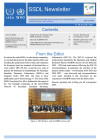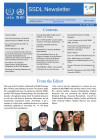Too little radiation can be ineffective, while too much can be harmful. Therefore, utmost care must be taken when administering a radiation dose. The IAEA provides calibration and postal dose audit services and develops internationally harmonized dosimetry codes of practice and guidelines for hospitals and calibration laboratories worldwide.
Getting the dose right
To get the dose right, it is crucial that the radiation doses associated with any medical practice, whether diagnosis or treatment, are accurately known. A dose measurement should be traceable to international standards so that a specified dose level means the same thing in different countries.
Using medical dosimetry for diagnosis and therapy
In hospitals, patients may have to undergo different kind of examinations, involving the use of ionizing radiation (X-rays or gamma rays) to assess their health status. These examinations will provide diagnostic images containing the anatomical information that medical doctors need to formulate a diagnosis and decide on a treatment for the patient.
When a patient is diagnosed with cancer, the treatment often involves the use of ionizing radiation, either through radiotherapy or nuclear medicine. In radiotherapy, ionizing radiation is used to target and destroy cancerous cells inside the patient’s body. In nuclear medicine, a liquid radiation isotope (generating ionizing radiation) is directly injected into the human body where it passes to the target organ. There, the radiation is selectively released inside the organ that needs treatment. The success of the treatment depends on whether the right dose was applied and how precisely the ionizing radiation targets the organ.
Adequate dose measurements and comprehensive quality assurance programmes ensure that medical physicists give patients the right doses – those that were prescribed to them by their physicians. The IAEA supports the activities of Member States by ensuring international consistency in dosimetry standards and by monitoring the implementation and dissemination of those standards to end-users. It also fosters research and development in dosimetry techniques and provides training of medical physicists.
Measuring the dose in non-medical circumstances
Dose measurements are also needed to monitor individuals who may be exposed to radiation in the course of their work or for members of the public. In such exceptional cases as nuclear or radiological accidents, dose assessments are equally important. In radiation protection dosimetry, the accuracy requirements are not as strict as for medical dosimetry, but proper traceability of the measurements with a defined level of uncertainty is also an important factor.








